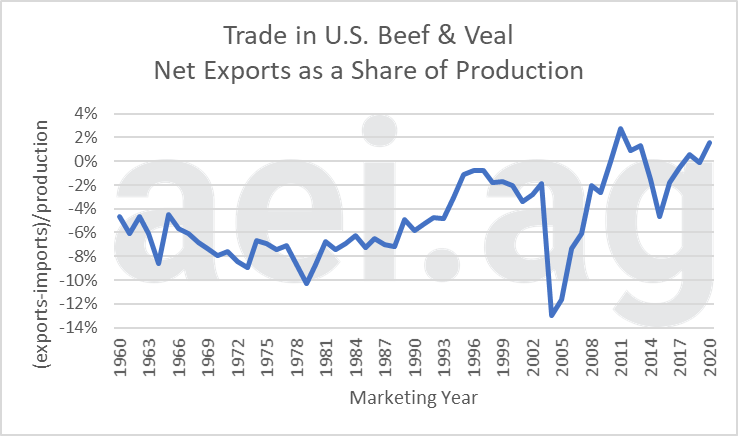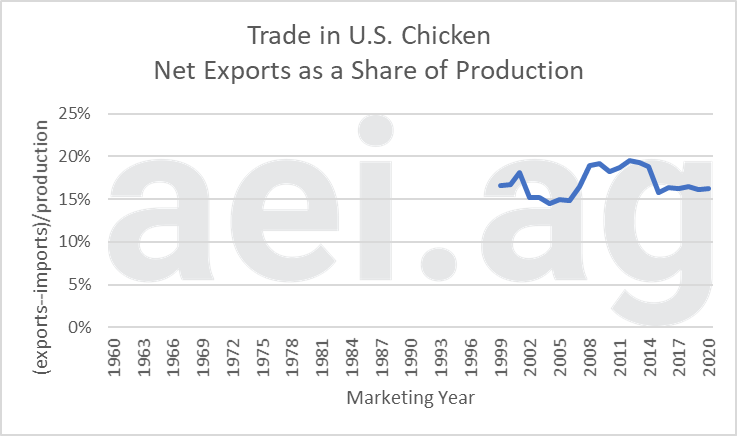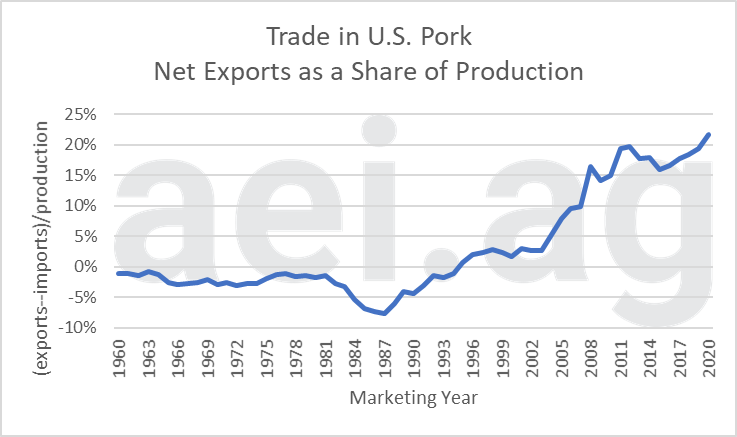Trade and U.S. Meat
In earlier posts, we have looked at the growing role of trade in global and U.S. crop production. The trends are mixed at the crop-level, but across all major crops, global trade has clearly become more significant over the last decade. This left us wondering about the livestock sector. This week’s post considers the impact of trade in the U.S. for beef, chicken, and pork.
The Data
Before jumping in, a couple of notes about the data. First, the data used for this post were reported by the USDA’s FAS PS&D database.
Second, the data presented are net exports as a share of total U.S. production. Net exports were calculated by taking exports minus imports. Positive values indicate that exports were larger than imports; negative values occurs when imports are larger than exports. Net exports, rather than just exports alone, are important as some meats have significant imports. For example, imports were equal to 11% of beef production and 3.5% of pork production in 2019. Imports are much less significant for chicken, 0.3% of production.
Finally, net exports were reported as a share of production to provide context. This is important as production has increased across the 60-years of data considered.
Beef & Veal
Figure 1 shows the role of trade in U.S. beef & veal. Before 1990, net exports of beef & veal were negative, with the magnitude equal to -4% to -8% of production. Beginning around 1990, a trend towards more exports began. By the early 2000s, net exports were still negative, but the magnitude (-2% of production) was smaller. Net exports plummeted in 2004 after the December 2003 confirmed case of BSE, which shut the U.S. out of many important export markets.
By 2011, net exports (+3%) turned positive as the U.S. exported more beef than imported. Net exports then retreated through 2015 before trending higher again. Again in 2018, the U.S. exported more beef & veal than imported. Trade was roughly balanced in 2019. For 2020, the USDA estimates net exports will be equal to 2% of production.
While it can be tempting to look at the recent data and focus on net exports being positive or negative, it’s essential not to lose sight of the bigger picture. Over the last three decades, a rapid shift towards more exports has been underway.

Figure 1. Trade of U.S. Beef & Veal, Net Exports as a Share of Production. 1960-2020f. Data Source: USDA FAS PS&D.
Chicken
Figure 2 shows U.S. chicken net exports as a share of production. The USDA first started reporting these data in 1999. Overall, the U.S. imports very little chicken, as noted above, and net exports have been equal to 15% to 20% of U.S. production. For a reference point, the USDA estimates corn exports to equal 13% of production for the 2019/2020 marketing year.

Figure 2. Trade of U.S. Chicken, Net Exports as a Share of Production. 1960-2020f. Data Source: USDA FAS PS&D.
Pork
Figure 3 shows the pork data. Similar to beef, pork has also seen a significant shift over the last three decades. Before 1990, the U.S. imported slightly more pork than it exported as net exports were -1% to -3% of production. After turning lower in the 1980s, net exports have trended higher for more than 30 years. In 2019 net exports were 19% of production. For 2020, the estimate is for net exports to reach 22% of production, the highest in 60 years.

Figure 3. Trade of U.S. Pork, Net Exports as a Share of Production. 1960-2020f. Data Source: USDA FAS PS&D.
Wrapping it up
Over the last three decades, a structural shift towards more exports of beef and pork has been underway. Before the 1990s, the U.S. imported more beef and pork than it exported. Since 1990, however, net exports as a share of production has trended higher.
While the trend has been towards more exports, the magnitudes vary. In beef & veal, 2020 net exports are estimated at +2% of production. For chicken (+16%) and pork (+22), net exports account for a much larger share of production.
It is no secret that trade can be an important source of growth for a sector. For example, in an earlier post, we noted that beef consumption in the U.S. has been extremely lackluster (0.2% annually between 1990 and 2016).
Looking ahead, trade is at the front of everyone’s mind. This is especially the case as U.S. livestock producers hope for even more exports in light of China’s African Swine Flu (ASF) challenges.
Click here to subscribe to AEI’s Weekly Insights email and receive our free, in-depth articles in your inbox every Monday morning.
You can also click here to visit the archive of articles – hundreds of them – and to browse by topic. We hope you will continue the conversation with us on Twitter and Facebook.
Source: David Widmar, Agricultural Economic Insights
